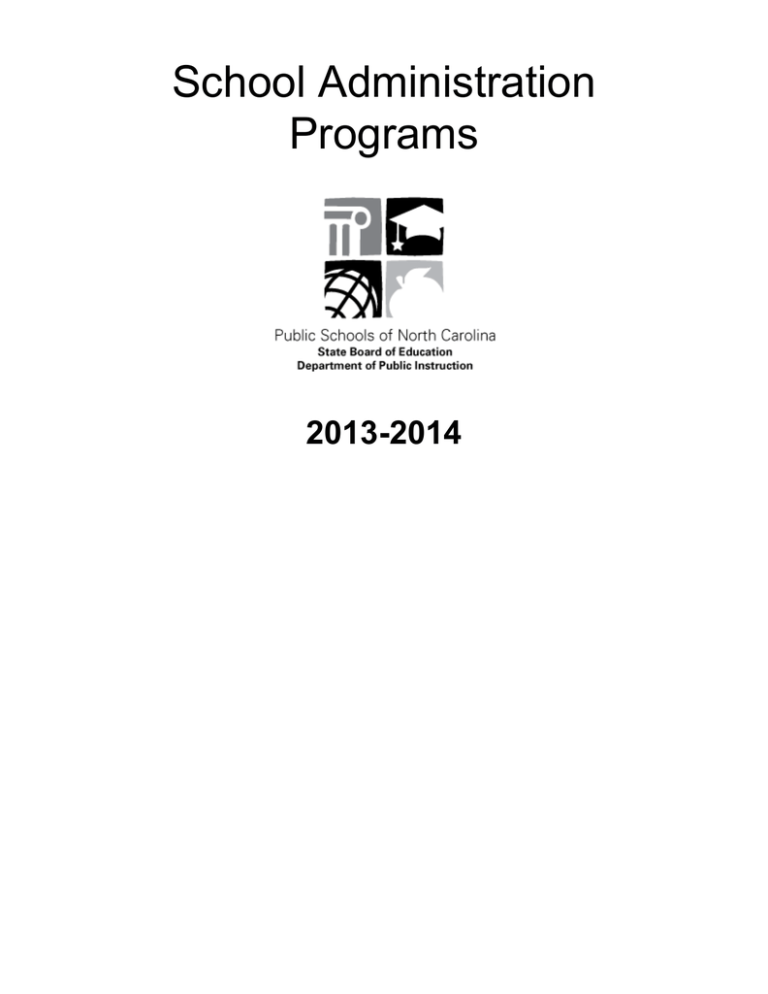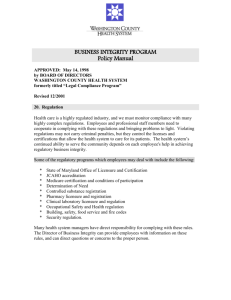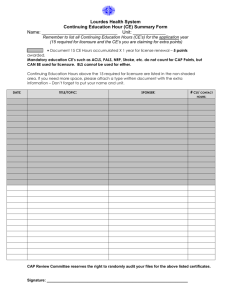School Administration Programs 2013-2014
advertisement

School Administration Programs 2013-2014 SCHOOL ADMINISTRATION PROGRAMS School administration programs are designed to prepare educational leaders who have the knowledge, skills, and dispositions to promote the success of all students. While specific course requirements vary from institution to institution, they are focused on enabling graduates to be able to facilitate the formation, articulation, and dissemination of a school or district vision of learning supported by the school community; promote and maintain a positive school culture for learning, by promoting effective instructional programs, applying best practices to student learning, and designing and implementing comprehensive professional growth programs for staff; manage organizational operations and resources in a way that promotes safe, efficient, and effective learning environments; collaborate with families and other community members, responding to diverse community interests and needs, and mobilizing community resources; understand the larger political, social, economic, legal, and cultural context of schools; and advocate for all students. During the 2013-2014 academic year 19 institutions were approved to offer school administration programs. The institutions are: Appalachian State Campbell University East Carolina University Elizabeth City State Univ. Fayetteville State Univ. Gardner-Webb University High Point University NC A & T University NC Central University NC State University Queens University* UNC-Chapel Hill UNC-Charlotte UNC-Greensboro UNC-Pembroke UNC-Wilmington Western Carolina University Wingate University Winston-Salem State University* * Did not provide institutional reports due to a campus-based decision to suspend admissions into the School Administration program. Quality of Students Entering the Programs Institutions with approved school administration programs seek to recruit and retain quality students who reflect the diversity of the state and nation. They work closely with their college/university graduate admission offices and area school systems to promote their programs. Brochures and other promotional materials are routinely distributed. A number of institutions offer off-campus programs designed to bring programs to prospective school administrators. School Administration Program Admission Requirements School Administration Program admission requirements vary from institution to institution. Most require prospective students to have a prescribed grade point average and to earn a satisfactory score on a standardized examination such as MAT or GRE. Many require references; a number require a writing sample (essay). Table XII summarizes the Fall 2013 statewide enrollment in school administration programs. Data for each individual institution are available in the Institutional Reports and Institutional Report Cards found on the Department’s website. Figure V contains enrollment data for school administration programs statewide over the five year period of 2009-10 through 2013-2014. Part-time and full-time school administration students are combined. Table XIII summarizes admission test results. The column MAT 1 reflects MAT scores based on the 0-100 scoring rubric; MAT 2 reflects the new MAT scoring rubric that ranges from 200 - 1 600. The column GRE 1 reflects the combined Verbal and Quantitative scores (each can range from 200-800); GRE 2 reflects the GRE analytical writing score which ranges from 0-6. Data for each individual institution are available in the Institutional Reports and Institutional Report Cards found on the Department’s website. Table XII: Enrollment in School Administration Programs Fall 2013 Full-Time M=Minority, T=Total State Totals Graduate M T 352 1,065 Part-Time Graduate Licensure Only M T 32 65 Graduate Licensure Only M T 238 552 Graduate M T 288 777 # of School Administration Candidates 3000 2500 2000 1500 1000 500 0 2009-10 2010-11 2011-12 2012-13 2013-14 School Administration 1587 1706 2139 1991 1842 School Administration Licensure Only 466 528 523 637 617 School Administration Total 2053 2234 2662 2628 2459 Figure I School Administration Candidate Enrollment from 2009-10 to 2013-14 Table XIII: School Administration Program Admission Data GPA MAT 1 MAT 2 GRE 1 GRE 2 State Average 3.41 39.86 402.47 1000.1 299.58 2 N 3,127 21 844 649 830 QUALITY OF STUDENTS COMPLETING THE PROGRAMS School administration programs are designed to prepare educational leaders who have the knowledge, skills, and dispositions to promote the success of all students. To this end, candidates are required to complete defined programs of study which include significant internship experiences. These experiences are expected to provide opportunities for synthesizing and applying knowledge and practicing skills through substantial, sustained, standards-based work in real settings, planned and guided cooperatively by the institution and school district personnel. The progress of candidates in completing program requirements is monitored and the competence of candidates is assessed throughout the program of study. In August 2011, the SBE approved the removal of the School Leaders Licensure Assessment (SLLA) exam as a licensure requirement. Candidates completing an approved program are required to complete the DPI licensure portfolio of electronic evidences. 3 Table XIV: Length of Time to Program Completion (MSA) Full-time Number of Semesters Graduate Licensure Only Totals Part-time 1-3 4 5 6 7 8 1-3 4 5 6 7 8 8 14 22 116 14 130 25 8 33 10 0 10 0 0 0 2 2 4 298 44 342 44 56 100 50 28 78 9 10 19 8 2 10 14 3 17 4 EMPLOYMENT AND PROGRAM SATISFACTION To determine the satisfaction with individuals who have completed the MSA programs and their employers, a survey was distributed to recent program completers employed in the public schools of North Carolina. Respondents were asked to rate their satisfaction with the MSA program in general, and the impact of the graduate program on the school leader’s ability to connect subject matter and learners' needs, implement research-based approaches, assume leadership roles, facilitate learning for diverse students, and engage in continuous professional development. Due to the historical low response rate on program satisfaction, and current budget constraints the survey of school administration program completers was not completed for the 2013-2014 school year. 5 REWARDS AND SANCTIONS School Administration Programs If schools are to succeed, they must be staffed with quality professionals. The quality of school administration programs is a significant factor in determining the quality of the school administrator’s profession. Because of this, programs should be assessed on a regular basis. One key method of assessing program quality is found in the MSA Program Approval process. This process required onsite reviews of school administrator programs by trained teams of professionals at least every seven years. To assist in carrying out this process and in assessing the on-going quality of executive preparation, a Performance Report was issued for each North Carolina college or university with an approved MSA program. Data from the program approval process and the IHE Performance Report was used to reward and sanction programs as required by the Excellent Schools Act. Historical State Approval Process Masters of School Administration Programs (MSAs) had to: (a) (b) (c) % Maintain annually a passing rate of at least 70 on the SLLA exam. Receive annually positive ratings (3 or 4) from at least 70 of graduates and employers responding to surveys Exhibit direct and ongoing involvement with the public schools. % An MSA program shall be designated as "Low Performing" if: (a) It does not meet 2 of the above 3 criteria in a single year; or (b) It does not meet the same 1 of the above 3 criteria twice in three years; or (c) It does not meet any 1 of the above 3 criteria for 3 consecutive years The public disclosure of the IHE Performance Reports serves as a means of rewards/sanctions itself, as institutions seek to attract students and garner alumni support. Further sanctions are described below. For any criterion that the institution does not meet, it will be required to submit a written plan to NCDPI detailing the actions that will be taken to correct the deficiency (ies); technical assistance will be available through the Teacher Education Section. The reports will be reviewed by the SEC, which may recommend further action (e.g., sending a team to campus; requiring additional information, etc.) If an institution is designated "Low-Performing," on two consecutive assessments, the Department will conduct an on-site review of the program. The results of this review will be reported to the SBE and may result in closure of the licensure program. A "rule of 5" will be applied to Praxis II and survey data; i.e., data with an "N" fewer than 5 will not be reported. Data will be banked until a minimum of 5 scores or responses are recorded and then reported. Current State Approval Process In January 2008, the State Board of Education (SBE) approved in concept a new program approval process, focusing on candidate’s outcomes rather than inputs, eliminating barriers to quality, and allowing greater institutional flexibility. By July 2009, IHEs were required to submit to the SBE “blueprints” of proposed programs revisioned to align with the new professional teaching standards for teachers and school executives. All revisioned programs were required to be implemented with the incoming cohort of Fall 2010. For the MSA cohort that began the program prior to fall 2010, they must complete either the SLLA (Praxis II for Administrators) or the new licensure portfolio. For students starting the MSA and add-on licensure programs in Fall 2010, all of these students are required to complete the DPI licensure portfolio. 6 Beginning in summer 2012, a statewide pilot was conducted to review leader candidate’s electronic evidences as artifacts of candidate’s proficiencies under the revisioned programs. A program approval process to demonstrate implementation of the IHE blueprint, review electronic evidences, involvement with public school partners, effectiveness of program graduates, and other relevant data is under development. 7



